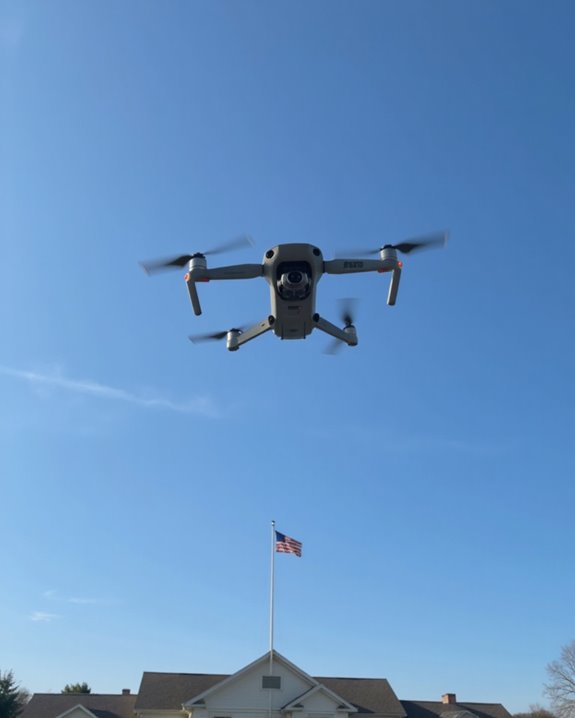Yes, people have absolutely tried to shoot down drones—from military officers hunting expensive MQ-9 Reapers to prison guards fuming at contraband deliveries! In real conflicts, groups like the Houthis in Yemen have downed U.S. military drones using Iranian-supplied air defense, and even correctional officers have run drills for rogue quadcopters sneaking over fences. High-tech jammers, anti-drone simulations, and AI trackers make it a serious game of cat and mouse. Want to know all the wild ways this battle plays out?
Key Takeaways
- Military forces worldwide routinely conduct training and real operations to shoot down drones in both combat and peacekeeping scenarios.
- The Houthis have successfully shot down several U.S. MQ-9 Reaper drones using advanced air defense systems, reportedly supplied by Iran.
- Iran-backed groups in Syria and Iraq have attempted and occasionally succeeded in shooting down U.S. military drones.
- Correctional facilities respond to drone incursions with detection systems but are generally prohibited by law from shooting down drones.
- Specialized counter-drone technologies, including jammers and AI-driven systems, are increasingly deployed to neutralize or disable drones without physical destruction.
Military Operations Targeting Drones
In today’s world, military operations targeting drones have become a hot topic—almost as popular as the drones themselves! Everywhere from peacekeeping deployments to high-stakes battlefields, troops are using training simulations to practice shooting down these flying machines. Why? Because drones, powered by AI and packed with tech, are now everywhere in modern warfare. Armies use anti-air defense systems—sometimes even old-school ones—to blast drones out of the sky, especially when costs matter. Clever engineers are also creating drone jamming systems that mess with drone controls, making them lose their way. Specialized counter-drone tools can even stop drones without hurting people nearby. With drone strikes on the rise, especially by non-state actors, military forces are constantly searching for smarter, safer ways to defend themselves! It is also crucial for military and security personnel to consider FAA-approved drone detection technologies to ensure legal and effective countermeasures are employed.
Houthi Attacks on U.S. MQ-9 Reaper Drones

Although news headlines often focus on high-tech battles, the story of the Houthis shooting down U.S. MQ-9 Reaper drones adds a new chapter to drone folklore. Since March 31, the Houthis have downed seven of these $30 million drones in Yemen—ouch, that’s over $200 million gone! Thanks to air defense systems, reportedly from Iran, Houthi narratives now boast about their success, even if not every claim is verified. These attacks aren’t just about bragging rights—they disrupt U.S. intelligence and give the Houthis a strategic edge, both domestically and regionally. It’s like a David and Goliath story, but with missiles. Investigations are ongoing, and with each strike, the Houthis’ growing capability becomes a bigger headache for U.S. planners. While active drone jammers are restricted due to legal regulations, protective measures such as signal blocking technologies are being explored to safeguard critical assets.
Drone Shootdowns in Conflict Zones
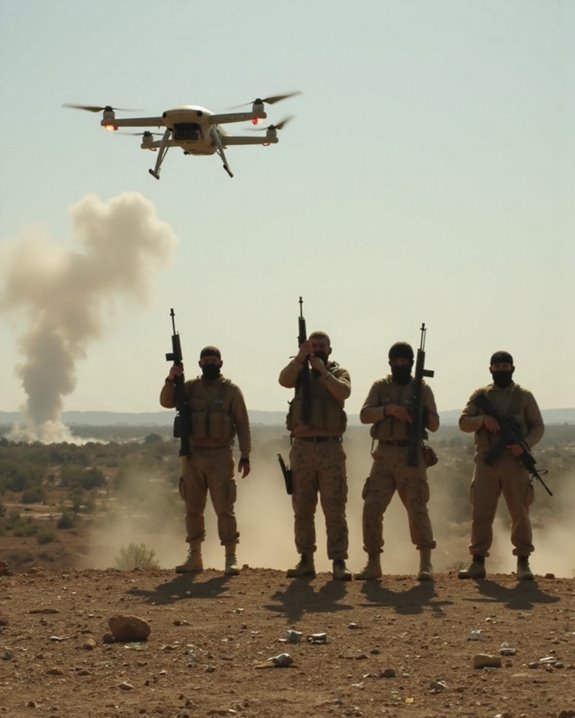
Ever wonder how tough it really is to shoot down a drone buzzing overhead in a warzone? Turns out, it’s like trying to swat a supercharged mosquito! Advanced military drones zip through the skies with incredible speed and maneuverability, making them hard targets. In places like Syria and Iraq, Iran-backed groups have tried shooting down U.S. drones—sometimes with partial success. When a drone falls, it can shake up zone stability, disrupt intelligence gathering, and even spark diplomatic drama. Civilian reactions vary, too; some cheer when drones are downed, while others worry about collateral damage or privacy invasions. The legal side? It’s a tangled web—international law, human rights, and a lack of clear guidelines keep everyone guessing. Effective drone interdiction often requires specialized equipment with significant range and velocity, such as the Umarex T4E HDR 68.
Counter-Drone Measures in Correctional Facilities
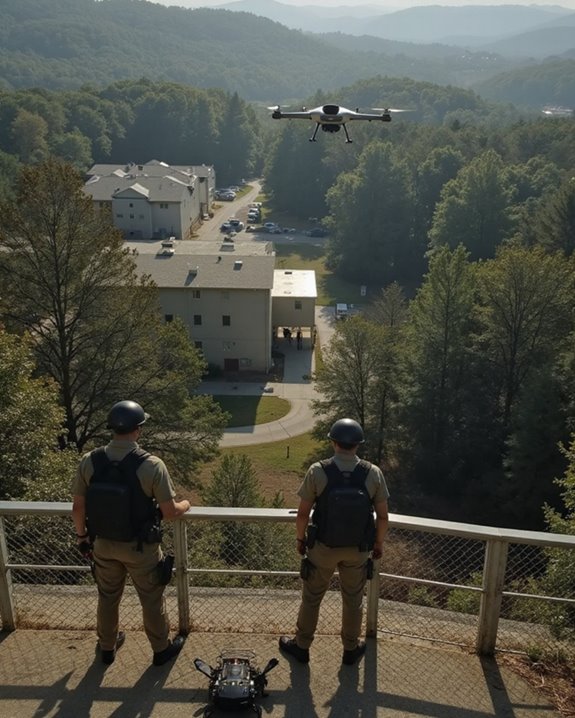
Drones—those buzzing, high-tech delivery birds—have become a real headache for correctional facilities across the country! These sneaky machines aren’t dropping off cookies—they’re delivering contraband, and prison security teams are scrambling to keep up. Staff rely on layered detection: think radar, AI-powered cameras, and even good old-fashioned human eyes. When a drone is spotted, early warning systems sound the alarm, setting Prison Drills into motion and triggering Lockdown Protocols to keep inmates away from any illicit “airmail.” Correctional officers, often new to drone tech, need constant training to respond fast and smart. And forget about shooting drones down—strict federal rules say “no way!” Instead, the focus is on tracking, gathering evidence, and working with law enforcement to catch the culprits.
Evolving Technologies for Neutralizing Drones
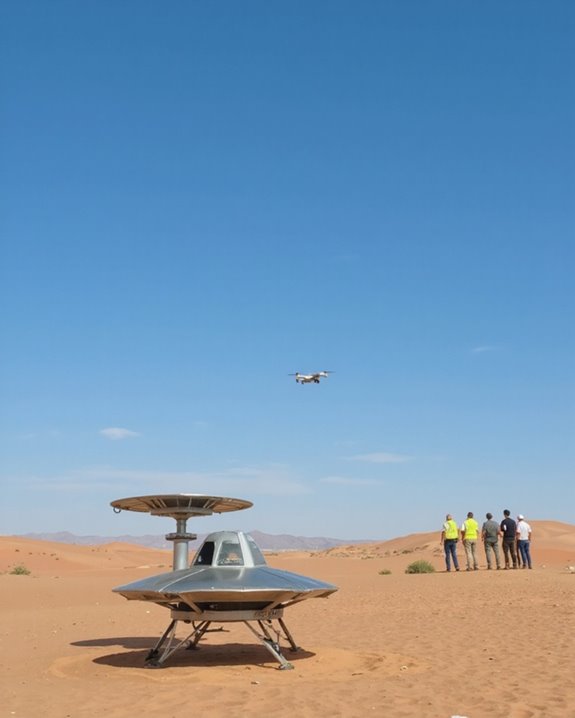
A whole new generation of counter-drone tech is shaking up the game, and it’s honestly pretty wild to see what these systems can do! From AI Tracking that can spot and follow drones before you even know they’re coming, to Sensor Fusion that mixes radar, cameras, and even microphones, today’s defenses are smarter than ever. Companies like Fortem Technologies and DroneShield use AI to sift through mountains of data, predicting threats in real-time. Imagine Rafael’s mobile system on a 4×4—radars, EO/IR sensors, and jammers all talking together! Origin Robotics’ BLAZE drone is even more sci-fi, chasing enemy UAVs with AI-powered precision. Electronic warfare techniques, like RF jamming, can zap drone signals without a single shot fired.
Financial and Strategic Impacts of Drone Shootdowns
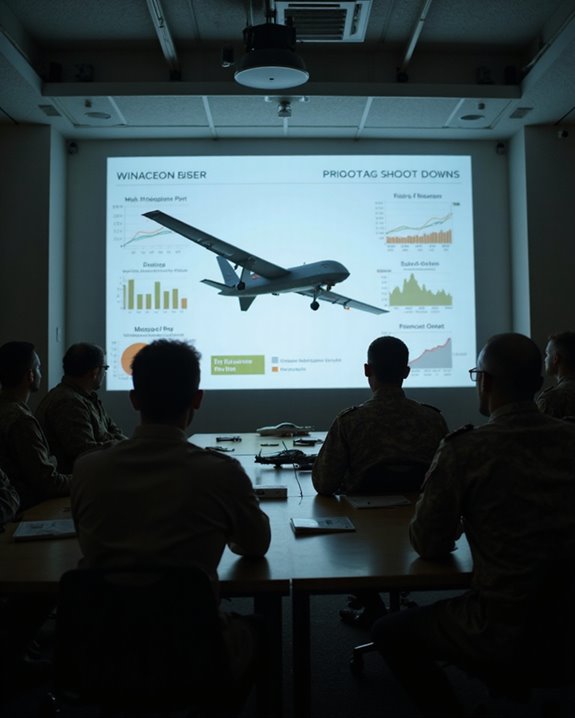
When it comes to shooting down drones, there’s a lot more at stake than just a busted gadget tumbling from the sky! Financial Losses can be massive—just ask anyone who’s heard about the $120 million U.S. military drone shot down by Iran. Even smaller incidents, like the drone that closed Gatwick Airport, led to huge economic setbacks and halted flights, leaving thousands stranded. Strategic Planning becomes vital, too, since every drone that’s taken down could mean damaged infrastructure, interrupted film shoots, or even stopped construction projects. The costs vary, from a few hundred bucks for a hobby drone to tens of thousands for a commercial one. Clearly, knocking a drone out of the sky is more than target practice; it’s a high-stakes decision!
Legal and Regulatory Actions Against Unauthorized Drones
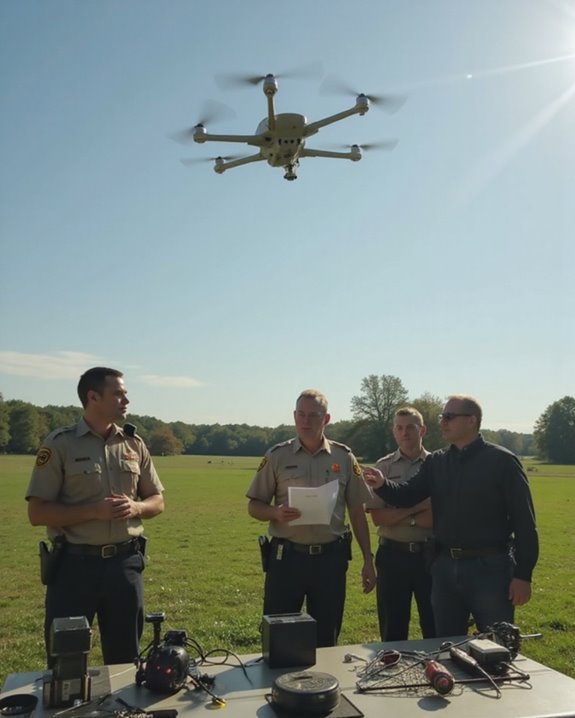
Every time someone flies a drone where they shouldn’t, a whole world of legal trouble can take off! The FAA doesn’t mess around—regulatory fines for unauthorized drone flights reached up to $75,000 per violation in 2024. That’s not pocket change! In August 2024 alone, proposed penalties totaled $341,413. Remember SkyPan International? They faced a record $1.9 million fine (though settled for $200,000). Certificate actions are another headache: the FAA can suspend or even revoke your Remote Pilot Certificate. Out of 70 cases, five pilots lost or had their certificates suspended—one even got a $3,000 fine on top! If you buzz near airports or power plants, beware. With detection systems in major cities, getting caught—and fined—has never been easier.
Frequently Asked Questions
Can Civilians Legally Shoot Down Drones Flying Over Their Property?
The current question involves whether civilians can legally shoot down drones over their property. Legal precedents and federal law prohibit such actions, regardless of privacy concerns. Violations may result in criminal charges, civil liability, and significant safety risks.
What Happens if a Drone Is Shot Down Over Private Land?
When a drone is shot down over private land, Drone Consequences include potential federal charges, civil liability, and costly legal battles. The Environmental Aftermath may involve falling debris, risk of injury, property damage, and broader public safety concerns.
Are There Insurance Policies for Drone Owners Against Shootdowns?
Policy providers primarily present protection for accidents, but policies rarely routinely reimburse for reckless shootdowns. Policy availability for such scenarios is scarce; claim procedures for shootdowns are complicated, often excluded, and may require negotiation or specialized endorsements for coverage.
How Can Hobbyist Drone Operators Protect Their Drones From Being Targeted?
To protect drones from being targeted, hobbyist operators may employ drone stealth techniques, avoid restricted areas, and use encrypted communications to resist signal jamming, while also staying informed about regulations and utilizing early-warning detection technologies for enhanced security.
Do Wildlife or Animals Ever Attack or Bring Down Drones?
Wildlife Encounters with drones sometimes result in Animal Aggression, including attacks. Birds, particularly raptors, have been documented striking drones, occasionally bringing them down. Reactions vary, with some animals exhibiting stress or defensive behaviors when confronted by drones.





